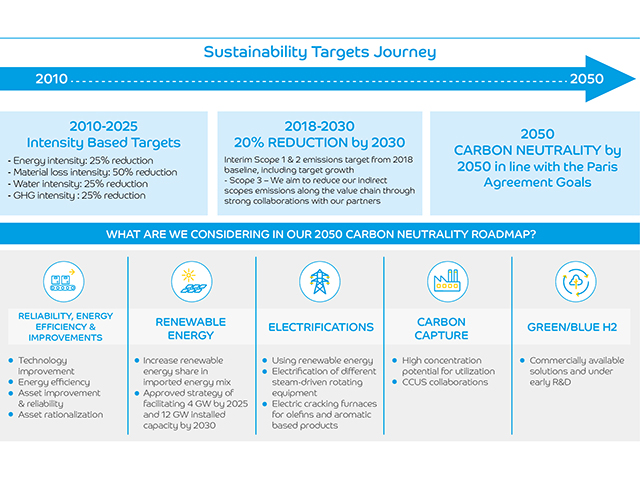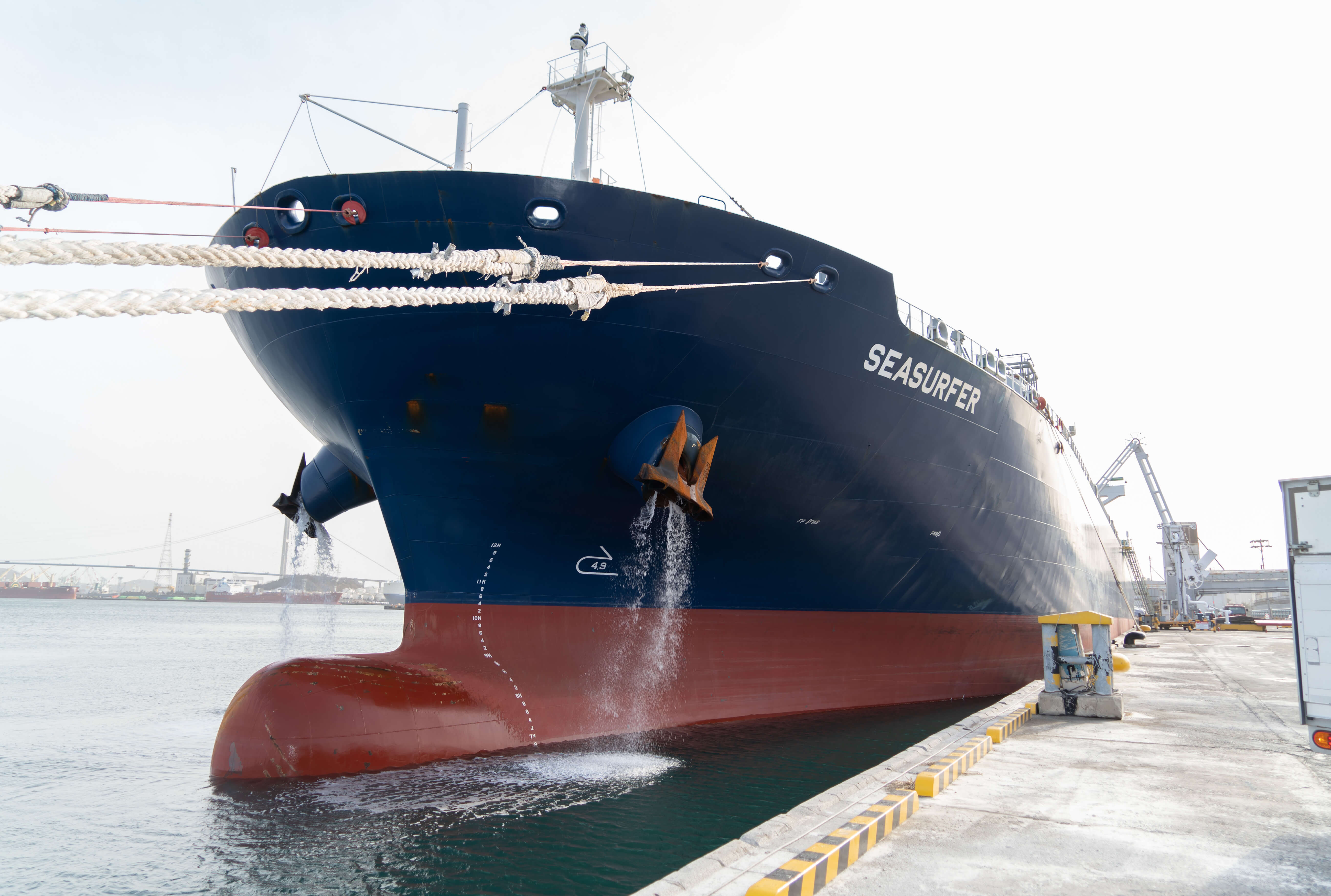Our Approach and Performance
CARBON NEUTRAL BY 2050
In 2021, we made a public pledge to ensure that all our operations are carbon neutral by 2050. To realize these ambitions, Energy Efficiency and Carbon Management (EECM) and representatives from all our businesses and Corporate Sustainability worked to develop SABIC’s Carbon Neutrality Roadmap. The Roadmap establishes the overarching vision for achieving net zero emissions by 2050 and an interim target of reducing GHG emissions (Scope 1 & 2) by 20% by 2030 (from a baseline of 2018). Alongside SABIC’s ongoing emphasis on circular and renewable feedstock, the Roadmap also identifies five primary pathways to achieving net zero carbon emissions: reliability, energy efficiency, and improvements; renewable energy; electrification; carbon capture; and green/blue hydrogen.
Since this baseline of 2018, SABIC has realized a reduction of 8% in absolute Scope 1 & 2 GHG emissions, primarily driven through our efforts in energy efficiency asset improvements and renewable power incorporation.

In 2022, all SABIC affiliates, under the guidance of EECM, developed affiliate-specific carbon neutrality roadmaps. These roadmaps are the first step in identifying the carbon abatement mechanisms specific to an affiliate and evaluating each program for proper planning of resources and investment.
This year, we also initiated projects in renewable energy, carbon capture, electrification and green/blue hydrogen. We celebrated the groundbreaking ceremony of our collaboration project with BASF and Linde to demonstrate technologies for large-scale electronically heated steam cracker furnaces. Once proven, the technology can have the potential to reduce carbon emissions from a cracking furnace by over 90% when coupled with renewable power. Through the CCUS Hub initiated by the Saudi Ministry of Energy as part of its CCE-NP to oversee GHG mitigation initiatives, SABIC plans to capture a total of 4 million metric tons annually of CO2, aiming for 2 million metric tons annually by 2030. In addition, as of Q4 2022, SABIC took another step forward in our long-term plan of carbon capture and utilization for methanol production at Arrazi, having recognized its future growth opportunities.
From now through 2030, major focus areas in SABIC’s Carbon Neutrality strategy are energy efficiency, renewable energy, and CCUS with US$ 3–4 billion capital expenditure anticipated. In order to minimize capital expenditure demands and utilize capital in an efficient manner, our intention is to replace fossil fuels with zero carbon alternatives, mostly utilizing existing technologies and leveraging power purchase agreements (PPAs) to replace grid-based electricity. Three of our main strategic actions to reduce carbon emissions by 20% by 2030 are:
– Renewable energy incorporation globally to reduce Scope 2 emissions
– Continuing our energy efficiency journey to achieve the SEEC second cycle target and beyond
– Capturing CO2 through the Saudi Arabia CCUS hub.
Post-2030, our major focus areas will shift to executing our electrification and hydrogen strategies in order to achieve our net zero goals by 2050. Many of these abatement measures are not yet commercialized and have a large capital expenditure requirement; however, progress is already underway to develop these technologies, i.e. SABIC’s joint development of an electric cracking furnace and forging industrial strategic partnerships for hydrogen hub development and off-taker agreements.
EXPLORING GREEN/BLUE AMMONIA
SABIC aims to grow its presence in the low-carbon ammonia market, also known as “blue” and “green” ammonia, through a series of projects ranging from production and marketing initiatives.
In 2022, we dispatched the world’s first commercial shipment of independently certified blue ammonia to South Korea. This represents a key milestone in SABIC’s journey to developing decarbonization solutions. Blue ammonia is a low-carbon alternative to conventional grey ammonia, developed by SABIC Agri-Nutrients Company in collaboration with Aramco. The full shipment consisted of approximately 25 kmt of blue ammonia.
In addition, Aramco and SABIC Agri-Nutrients obtained the world’s first independent certification recognizing blue hydrogen and ammonia production. TÜV Rheinland, a leading independent testing, inspection and certification agency based in Germany, granted the certifications to SABIC Agri-Nutrients in Jubail for 37,800 metric tons of blue ammonia. The certification opens new market opportunities for using ammonia as a clean fuel and will propel us towards a more sustainable future.
As the cost of renewable energy continues to decrease, the production of green ammonia via green hydrogen through water electrolysis has grown more cost-effective. In the coming years, it will eventually compete with conventional ammonia production derived from fossil fuel. SABIC Agri-Nutrients is exploring opportunities in green ammonia production that uses sustainable electricity, water, and air in a bid to reduce the carbon footprint in existing affiliates. This year, the possibility of installing a small electrolysis unit is under feasibility evaluation; the overarching goal being to reduce GHG emission and comply with local regulations.

The world’s first commercial shipment of accredited independently certified blue ammonia – part of a collaboration between SABIC Agri-Nutrients and Saudi Aramco – arrives in South Korea.
SAUDI ENERGY EFFICIENCY PROGRAM (SEEP)
SABIC is committed to SEEP and is working with various virtual teams established by EECM to develop a roadmap offering different options to support the government’s 2025 SEEP goals. In 2022, SABIC continued to progress in the SEEC 2nd Cycle journey with a commitment to bring efficiency of operations & energy usage on par with global trends. To achieve this ambitious target, we invested US$ 1.38 billion into 80 affiliate projects and 8 mega-projects. We commissioned the YANPET EG-II Energy Efficiency project that reduced the plant’s energy intensity by 30% and made substantial progress on completing the Sharq EG SEEC project development plan with FEED activities progressing to the final stage (it is expected to improve the energy efficiency of the EG-1 and EG-2 plants by 20% and feedstock efficiency by approximately 2% compared to the 2018 baseline). We also completed the FEED phase of the Yanpet EG-1 Efficiency Improvement Project (which is expected to improve energy efficiency by 25% and feedstock efficiency by 7%).
Moreover, improving the energy efficiency of our operations is a vital tool overall in driving progress toward our climate goals. Efficiency optimizations planned in site-specific carbon neutrality roadmaps, along with commencing decommissioning energy intensive sites in 2025, will lead to an expected reduction of about 7.2 million tCO2e by 2030.
CLIMATE GOVERNANCE
Climate governance is a means to ensuring that our climate strategy is carried out across SABIC’s departments and teams. As ESG performance tracking is increasingly embedded across SABIC, it is critical to assess whether the Company is following appropriate and effective processes. Accordingly, we restructured the ESG Reporting Steering Committee to create more engagement both functionally and regionally to oversee the strategic transition to integrated reporting. The ESG Reporting Practitioners Group will deal with introducing new disclosures in the immediate short-term while focusing on developing more granular ESG content over the next 2–3 years. We also created a dedicated PMO to develop ESG processes for internal focus; this will enable SABIC to build capacity in critical areas. Taken together, we believe these initiatives will permit a more integrated ESG approach that improves addressing stakeholder needs, meets evolving regulations, enables responsible long-term growth, and drives a sustainable portfolio.
CLIMATE RISK AND RESILIENCE
We are working to incorporate climate risk and resilience into our strategy to ensure that SABIC is prepared for the inevitable impacts of climate change. Our main tool is renewable energy to lower Scope 2 GHG emissions; to this effect, our goals are to secure 4 GW of renewable capacity by 2025 and 12 GW by 2030. Our polycarbonate plant in Cartagena, Spain, is set to become the world's first large-scale chemical plant to run on 100% renewable power in 2024 and reduce CO2 emissions by as much as 70 kt, keeping us on track to meet our near-term target of a reduction in GHG emissions (Scope 1 & 2) of 20% by 2030.
CORPORATE DIGITALIZATION PROGRAM
SABIC embraces digital technologies and new business models that offer end-to-end visibility and actionable insights. SABIC rolled out a company-wide digitization strategy that covers multiple domains such as supply chain, manufacturing, market and sales, procurement, and product innovation. In 2021, SABIC made plans to implement its Corporate Digitalization Program across eight affiliates after its successful pilot project. This year, the preparation phase was completed, laying the foundation for further progress on digitalization in 2023.
Our Performance
KEY METRICS
These metrics illustrate performance changes in GHG emissions, energy use, freshwater use, material loss, and flaring reduction compared to 2010. Total CO2 utilization is the absolute usage in 2022. The intensities are based on units per metric ton of external product sales.
-
GREENHOUSE GAS INTENSITY
21.8%
reduction
-
Energy
intensity14.6%
reduction
-
Water
intensity22.4%
reduction
-
Material-loss intensity
47.6%
reduction
-
Flaring
(tCO2e)1660550
-
Flaring
emissions55.2%*
reduction
-
Total CO2 utilization
3.82*
(million t)
-
Absolute Waste
1.4%
reduction
-
ABSOLUTE GHG (tCO2e)**
(TOTAL SCOPE 1&2)
8%
reduction
* Assured by KPMG
** From 2018 baseline
Our reporting boundary for our Environmental Sustainability KPIs is in line with current financial consolidation; however, we have opted to include 3.5 SABIC affiliates – Kemya, Sharq, Yanpet and 50% of SAMAC – that were moved outside financial boundaries in 2020 as part of the total numbers.
